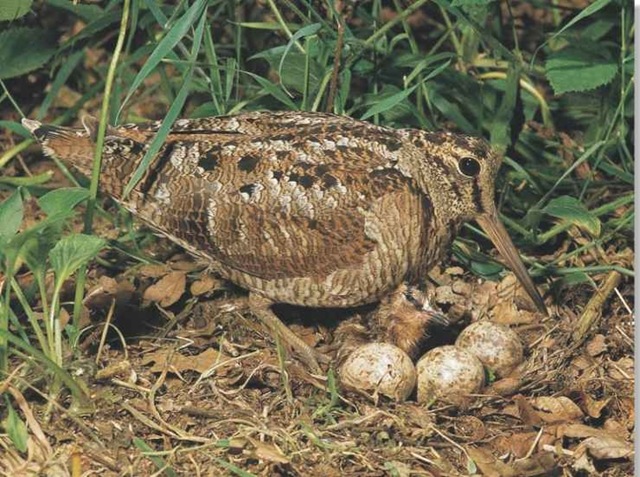ORDER
Charadriiformes
FAMILY
Scolopacidae
GENUS & SPECIES
KEY FEATURES
• Feather pattern looks like dead leaves
• Feeds after dark in ditches and bogs
• Eyes are on the sides of its head so it can watch for danger from behind while feeding
• Female feigns injury to lure a predator away from her hidden young
WHERE IN THE WORLD!
Found from the Atlantic islands off North Africa, east to Japan; in winter, many woodcocks fly south to India, China, Korea, and Vietnam

Lifecycle
To protect itself from its many enemies, the ground-nesting woodcock has evolved a subtly patterned plumage that provides this secretive bird with a cloak of invisibility.
habitat
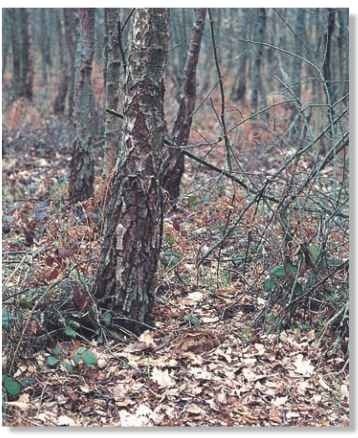
A Can you see it? Camouflage conceals the woodcock superbly.
The woodcock lives in a secret world of trees and rotting leaves, favoring oak, sycamore, and cherry with brambles and
other shrubs growing thick on the ground. It also lives in pine-woods and other conifer stands, as well as damp heaths. Because it probes for worms, the woodcock needs access to wet hollows and ditches, where soft soil makes it easier to feed at night.
In fall, many woodcocks migrate south to warm, food-rich habitats. Birds of northern Europe spend winters in Britain, France, the Netherlands and Spain. Migrating woodcocks may cross European coasts, landing exhausted on sand dunes or heaths.
food & feeding
The woodcock rouses itself in the evening to forage alone. For those that stay behind in winter, when the ground is hard and worms are out of reach, it may walk the forest floor by day, searching for berries and seeds, even a few scraps of flesh from dead birds.
Normally, however, the woodcock sinks its long, straight bill into the soft, deep soil and leaf mold, probing until it touches something it can eat. The gentle bobbing up and down movement makes it even harder to spot among trembling leaves and swaying twigs.
Once the woodcock has found an edible morsel, it pulls it from the ground and snaps it up. If the prey is small enough, the bird eats it without even withdrawing its bill from the soil.
More than half of all woodcocks die before they are a year old. In parts of northern Europe, as many as three-quarters of those that hatch die within the first few months.
A chick can walk around and pick at food close to the nest within a few hours after hatching.
Woodcocks almost always feed alone. Groups of young stay together only for one or two weeks after they learn to fly.
behavior
The woodcock’s key to secrecy lies in being active mainly at night and in crouching low if approached. It can feed entirely by touch in pitch darkness among long vegetation, inside ditches or under the leaves of ferns and brambles. In poor winter weather, however, it may move into open places to forage.
The bird is most conspicuous in the early summer, performing low courtship flights over the trees at sunset. Even then, it may only be visible as a silhouette against the sky.
HIDE AND SEEK
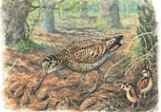
1 Feed…
A female and chicks peck for food, close to their nest in the forest. While feeding, she keeps watch all-around for predators.
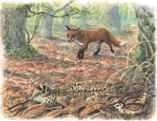
2 Hide…
A fox arrives. The woodcock and her chicks instantly crouch down so their plumage merges with the surrounding leaf litter…
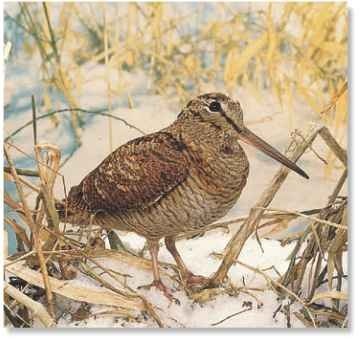
A Cold comfort
The snows of winter drive many woodcocks south to sunnier countries.
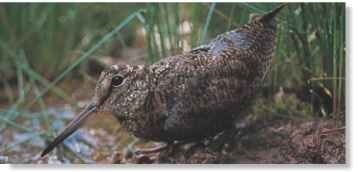
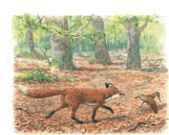
3 Trick…
…but the fox finds them. The female flies away in a haphazard manner, feigning a broken wing, to lead the fox away from her chicks.
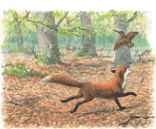
4 Escape
Just in time, the woodcock flies up and eludes the fox. When the coast is clear, the bird returns to her chicks at the nest.
breeding
In spring, the male performs a special flight known as “roding” to advertise his presence to females in the area. He flickers over the treetops along regular routes, uttering croaking grunts and sharp whistles. Sometimes, the flight is also performed by a male to warn rivals away from his “patch.” Males often chase each other, calling loudly or even fighting.
After the female has paired and mated, she lays her eggs on the ground among vegetation. The male woodcock may then leave her to find another mate.
Woodcock chicks start life covered in downy, mottled plumage that helps to conceal them from danger: Although the young birds can peck at food on their first day, their bills are still short, so they rely on an adult to bring them food. The chicks can flutter their wings at 10 days old, and fly properly at 15 to 20 days. They finally leave the nest only two or three weeks after hatching from the egg.
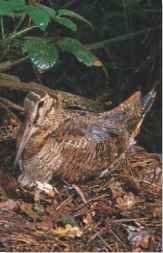
A Sitting tight
The female’s camouflage allows her to brood safely.
Up and away The chick grows rapidly; the power of flight lets it escape ground predators.
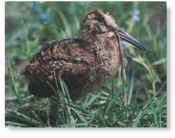
conservation
The woodcock is considered a game bird; many are shot for sport every winter. Summer is usually a less difficult time for the woodcock, although very hot, dry weather can affect local populations because the birds need access to muddy feeding areas. Stretches of dense woodland are also important habitats, as are the habitats of its southern winter grounds. Because much of the remaining woodlands of Europe and Asia are protected, the woodcock’s future is almost certainly secure.
PROFILE
Eurasian Woodcock
The secretive woodcock relies on its mottled plumage to hide among the leaf litter while it keeps a lookout for danger with its large, dark eyes.
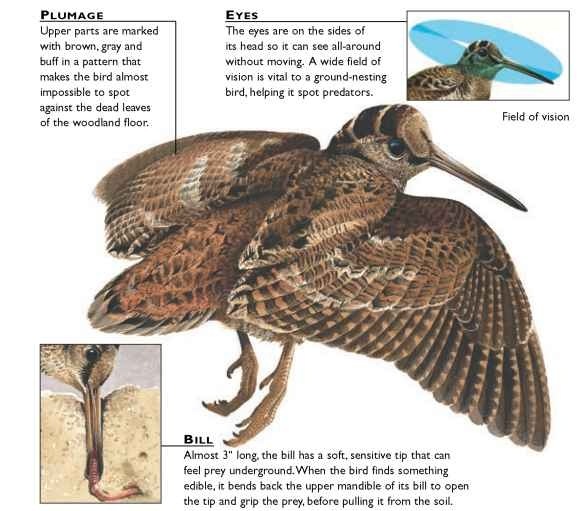
Creature comparisons
Woodcocks and snipes belong to the Scolopacidae, a family whose members typically have long legs and a long, straight bill used for probing soft ground. Woodcocks spend much time in woods, while snipes prefer damper areas. Woodcocks therefore have proportionally shorter legs and bills than snipes.
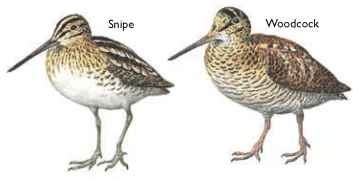
| VITAL STATISTICS | |
| Weight | 8-14 oz. |
| Length | 14″ |
| Wingspan | About 24″ |
| Sexual [ Maturity | Female 1 year, male 2 years |
| Mating : season | March through July |
| Number [ of Eggs | 2-5 |
| Incubation : Period | 22 days |
| Breeding Interval | 1 year |
| Typical | Earthworms, beetles, insect larvae, crickets; some berries when the ground is frozen |
| Lifespan | 12-15 years |
RELATED SPECIES
• There are six species 1 of woodcock in the family Scolopacidae, including the American woodcock, ; Scolopax minor, and the small Amami woodcock, which is found only on the Ryukyu Islands in the ; Pacific Ocean. Members ! of this family (most are shorebirds), include curlews, ruffs, sandpipers, snipes, and turnstones. These species typically t breed in the Northern Hemisphere, flying south for the winter.
